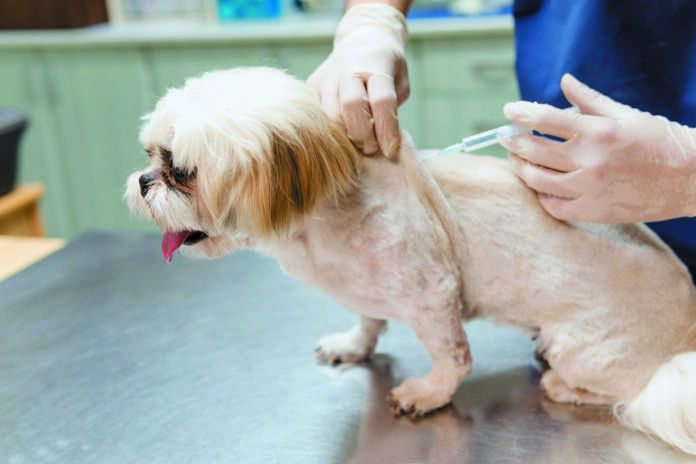Three main reasons for giving injections at home — and how even the squeamish can get used to administering them.When a veterinarian tells a client that their dog requires regular injections, some people start out by saying, “I can’t do that; I can’t deal with needles,” reports Tufts veterinarian Armelle de Laforcade, DVM. But, she says, “people who think they couldn’t go near a needle, once they try it, realize it’s not that bad.”
One reason people learn to cope quickly is that dogs themselves don’t have needle phobias, so they don’t fear the injections and make them difficult to administer. Another is that people soon realize that with injections, their dog feels better. Their health improves, and maybe their lifespan. That’s a big motivator even for those who don’t feel comfortable about giving shots.
Shots at home may be required for any number of conditions, but there are three that make up the lion’s share of why people have to become their dog’s home health nurse and give a daily jab (or two).
Chronic kidney failure. Much of the kidneys’ job is to flush waste from the body via the urine while holding onto as much water as possible. But if the kidneys start to fail, a dog will lose too much water and become perennially dehydrated — even if she tries to compensate by drinking more. That’s where daily injections of fluid at home might come in.
You can insert the needle pretty much anywhere on a dog’s body, “but between the shoulder blades on the back of the neck works particularly well,” Dr. de Laforcade says. “There’s a lot of loose skin there. We tell clients to pinch the skin in a shape sort of like a tent, or an upside down V. Then you put the needle through the base of the tent’s ‘front flap.’ If you go too near the top, you could end up sending the needle out through the other side rather than keeping it in the body.”
Some dogs receive up to a liter of fluid — a prescribed combination of water and electrolytes in particular concentrations. (You don’t have to do the mixing. It comes prepared.) It can take about 10 minutes for the solution to go in completely. The fluid makes its way to the needle from a bag that hangs from a hook above the dog.
Diabetes. Dogs with diabetes need to get an insulin shot either once or twice a day, with little wiggle room in the timing. But the needle is tiny, making it easier for people who are needle phobic. If a Tufts client is really scared, we’ll start by having the person inject an empty plastic bag, or perhaps the skin of an orange.
Again, between the shoulder blades is a good spot. The same “tent” is made out of the skin. Like fluid for kidney failure, the injection is subcutaneous — under the skin. This is not a deep dive into muscle. The biggest thing to watch for is the dose. It’s all too easy to give a tenfold overdose — say, 50 units instead of 5 — because of the way the syringes are marked. The difference between the two is less than a tenth of a teaspoon, so you can’t see it. It’s not an issue once you get used to it, but it does require very close attention.
Blood thinning. People can take warfarin (Coumadin) to thin their blood, if necessary. But it needs a lot of monitoring. You have to keep going to the doctor to have your blood levels of the medicine checked because absorption is variable — and because different foods can interfere with the drug’s action. For people with dogs, frequent trips to the vet for blood monitoring would prove too inconvenient, not to mention expensive. There are options available for dogs that don’t require intensive monitoring, like rivaroxaban. “It’s an amazing drug,” Dr. De Laforcade says, “but it is super expensive — as much as thousands of dollars a year.”
That’s why dogs who need blood thinning (most often because they are prone to clots) are often given subcutaneous injections of less expensive heparin at home — once again at the bottom of a “tent” made between the shoulder blades. Sometimes a dog will be given the drug for a strictly defined period, maybe two or three weeks. In other instances, it’s a long-term, twice-daily protocol, albeit a more forgiving one time-wise than the insulin protocol for diabetes. For however long it’s prescribed, it’s a lifesaver, just like the other injected drugs.





